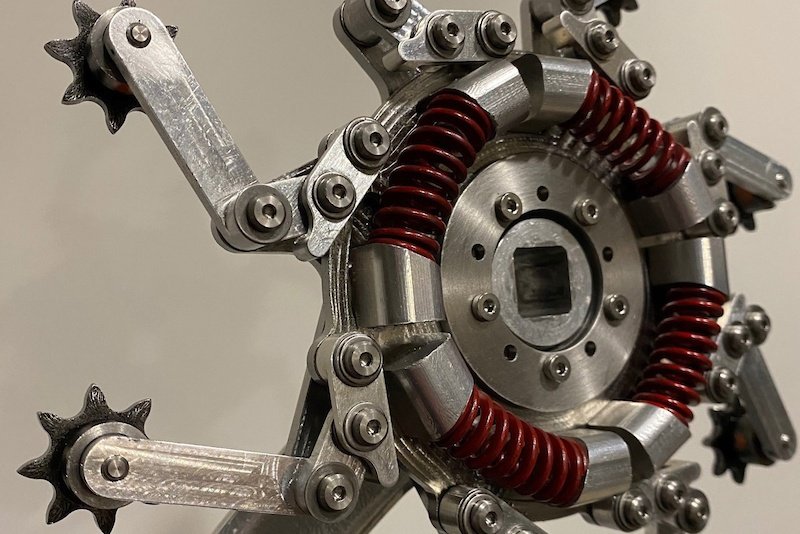Then along came wireless, electronic shifting, and the recently introduced automatic and coast shifting features for eMTBs. More recently, gearbox technology, which has been around for years, was seen combined with his eBike motor in a single sealed unit that does it all.
All of this is impressive, but it’s definitely more or less incremental. When it comes to drivetrains, it’s rare to see anything completely out of the field. So, over the past few days, my interest has been piqued by the publication of Haven Mercer’s patent for an “automatic bicycle transmission system.”
What we have here is a continuously variable transmission. That is, the gear ratio varies between the upper and lower limits, and the number of gears is not set. The number is virtually infinite. And the system is not only fully automatic, but also fully mechanical. We asked the inventor himself for more details.
I was happy to hear that Mercer’s continuously variable transmission is more than just a concept. In fact, he created a working, rideable prototype.
And he rode a mountain bike. In fact, his goal was to develop a system that worked well enough for trail riding, reasoning that if it could handle the demands of mountain biking, it could probably easily handle the demands of road cycling as well. fair enough.
How does it work?
The system centers around the ability of the chainring (for lack of a better word) and rear sprocket to automatically extend and retract in response to varying torque inputs. Both consist of a number of pulley wheels distributed around a center of rotation, each supported by a linkage, whose position is determined by a spring and the amount of torque applied at any given moment.
The chainring is constructed with a mechanism that biases the pulley wheels into an extended position so that each pulley wheel is at its furthest point from the center of rotation when the pedals are unloaded. The chainring here is the maximum effective size.
Before continuing with this discussion, it is important to note that each pulley wheel is on a one-way bearing. On a chainring, the pulley can rotate clockwise, but not counterclockwise.
So, when torque is applied to the pedals and the chain is pulled through the system, the last pulley engaged locks onto the chain, effectively becoming the torque-sensing element. The greater the applied torque, the greater the spring compression force and the corresponding reduction in effective chainring size.
In fact, when the torque-sensing pulley compresses, all the other pulleys also compress at the same time. The fact that the pulley wheel can rotate clockwise allows the chain to be fed so that it does not simply eject as the distance between adjacent pulleys decreases. The same goes for lower torque, which increases the effective chainring size.
The mechanism is reversed for the rear sprocket. Here, the spring and link system is configured to bias the sprocket towards the smallest possible size, with the pulley wheels closest to each other.
Therefore, under no load, the transmission is in the hardest gear. As you pedal, the effective size of the rear sprocket increases and the effective size of the chainring decreases, moving the system toward relatively easy gears. As momentum increases and the rider’s torque input decreases, the rear sprocket shrinks and the chainring increases in size. The transmission automatically adjusts gears according to the rider’s demands.
Doesn’t it have a built-in chain tensioner?
It occurred to me that, in theory, it might be possible to run this system without a chain tensioner. It’s not too difficult to understand that as the chain length requirement at the chainring increases, the chain length requirement at the rear sprocket decreases. While that is true, the two are not equivalent.
Haven Mercer, the inventor of this continuously variable transmission, explained that the system actually requires two chain tensioners instead of one. This is because the ends stretch at different rates, which can cause unwanted chain sag along the top and bottom chain lines. The upper tensioner also acts as a chain guide of sorts, which seems quite necessary given how violently the chain bounces up and down as it feeds into the chainrings.
Who is this alternative bicycle transmission for?
As mentioned earlier, inventor Haven Mercer intends to develop this transmission to a level sufficient for mountain biking, technical climbing, etc. The current prototype has issues, the main one being that the springs are too light and therefore tend to compress under pedaling loads. As a result, he says the ride is “a little squishy” at the moment.
It’s easy to imagine that the perfect spring rate may not exist, or at least not be the same for every rider or every type of terrain. That being said, Haven plans to design the springs to be easily replaceable by the end user.
Another concern is the durability of one-way bearings, not to mention the numerous durability issues that can arise from having so many moving parts.
Without riding it, it’s hard to judge how well it will perform in any situation. But the fact remains that this invention eliminates the need for shifting, allowing riders to pedal without thinking about what gear they are in or want to be in. The transmission simply adapts to the rider’s input. .
This has the potential to truly improve safety, especially in situations when driving in heavy traffic. Especially for people who ride bikes very rarely and are not very knowledgeable about handling them. The less a person has to think, the more they can pay attention to the road and other road users around them.
